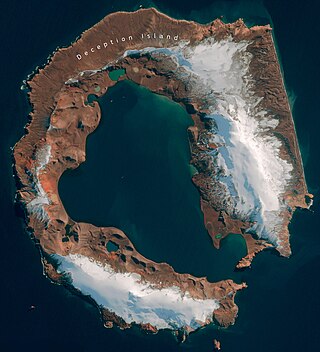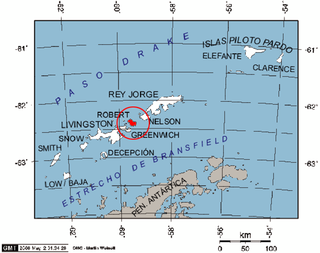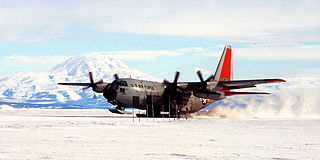Related Research Articles

Deception Island is an island in the South Shetland Islands close to the Antarctic Peninsula with a large and usually "safe" natural harbor, which is occasionally troubled by the underlying active volcano. This island is the caldera of an active volcano, which seriously damaged local scientific stations in 1967 and 1969. The island previously held a whaling station. It is now a tourist destination with over 15,000 visitors per year. Two research stations are operated by Argentina and Spain during the summer season. While various countries have asserted sovereignty, it is still administered under the Antarctic Treaty System.

Vinson Massif is a large mountain massif in Antarctica that is 21 km (13 mi) long and 13 km (8 mi) wide and lies within the Sentinel Range of the Ellsworth Mountains. It overlooks the Ronne Ice Shelf near the base of the Antarctic Peninsula. The massif is located about 1,200 kilometres (750 mi) from the South Pole. Vinson Massif was discovered in January 1958 by U.S. Navy aircraft. In 1961, the Vinson Massif was named by the Advisory Committee on Antarctic Names (US-ACAN), after Carl G. Vinson, United States congressman from the state of Georgia, for his support for Antarctic exploration. On November 1, 2006, US-ACAN declared Mount Vinson and Vinson Massif to be separate entities. Vinson Massif lies within the unrecognised Chilean claim under the Antarctic Treaty System.

Lincoln Ellsworth was a polar explorer from the United States and a major benefactor of the American Museum of Natural History.

Llanishen is a district and community in the north of Cardiff, Wales. Its population as of the 2011 census was 17,417.

Paul Allman Siple was an American Antarctic explorer and geographer who took part in six Antarctic expeditions, including the two Byrd expeditions of 1928–1930 and 1933–1935, representing the Boy Scouts of America as an Eagle Scout. In addition to being an Eagle Scout, Siple was also a Sea Scout. His first and third books covered these adventures. With Charles F. Passel he developed the wind chill factor, and Siple coined the term.

Operation HIGHJUMP, officially titled The United States Navy Antarctic Developments Program, 1946–1947,, was a United States Navy (USN) operation to establish the Antarctic research base Little America IV. The operation was organised by Rear Admiral Richard E. Byrd, Jr., USN (Ret), Officer in Charge, Task Force 68, and led by Rear Admiral Ethan Erik Larson, USN, Commanding Officer, Task Force 68. Operation HIGHJUMP commenced 26 August 1946 and ended in late February 1947. Task Force 68 included 4,700 men, 13 ships, and 33 aircraft.

This is a timeline of the history of New Zealand's involvement with Antarctica.

Esperanza Base is a permanent, all-year-round Argentine research station in Hope Bay, Trinity Peninsula. It is one of only two civilian settlements in Antarctica. The base's motto is Permanencia, un acto de sacrificio.

Robert Island or Mitchells Island or Polotsk Island or Roberts Island is an island 11 miles (18 km) long and 8 miles (13 km) wide, situated between Nelson Island and Greenwich Island in the South Shetland Islands, Antarctica. Robert Island is located at 62°24′S59°30′W. Surface area 132 km2 (51 sq mi). The name "Robert Island" dates back to around 1821 and is now established in international usage.

Williams Field or Willy Field is a United States Antarctic Program airfield in Antarctica. Williams Field consists of two snow runways located on approximately 8 meters (25 ft) of compacted snow, lying on top of 8–10 ft of ice, floating over 550 meters (1,800 ft) of water. The airport, which is approximately seven miles from Ross Island, serves McMurdo Station and New Zealand's Scott Base. Until the 2009–10 summer season, Williams was the major airfield for on-continent aircraft operations in Antarctica.

Friesland Ridge is a ridge on Livingston Island in the South Shetlands, part of the Tangra Mountains. The summit, Mount Friesland, which rises to 1,700 metres (5,600 ft), is the northwesternmost of the ridge's six main peaks. Its elevation was estimated at 1,684 metres (5,525 ft) by a 1995/96 Bulgarian survey; the present figure was produced by a 2003 Australian GPS survey, and closely matched by the Bulgarian survey Tangra 2004/05.

St. Boris Peak is an ice-covered mountain rising to 1,700 m in Friesland Ridge, Tangra Mountains on Livingston Island in the South Shetland Islands, Antarctica. It is the first or second highest peak of both the mountains and the island along with Mount Friesland. The two are connected by a short saddle of elevation 1649 m dominated by ‘The Synagogue’, a sharp-peaked rock-cored ice formation abutting upon the central summit of St. Boris Peak. The peak is also connected to Simeon Peak by Paril Saddle, and surmounts Huntress Glacier to the northwest and west, and Macy Glacier to the southeast.

James William Slessor Marr was a Scottish marine biologist and polar explorer. He was leader of the World War 2 British Antarctic Expedition Operation Tabarin during its first year, 1943–1945.

Cardiff Arms Park Male Choir is a Welsh Male choir based at Cardiff Arms Park in Cardiff, Wales, United Kingdom.

Landreth Glacier is the steep 2.3 km long and 600 m wide glacier on the southeast side of Imeon Range, Smith Island in the South Shetland Islands, Antarctica, which is draining southeastwards from Mount Foster between the side ridges separating it from Rupite Glacier to the north and Dragoman Glacier to the south, and flowing into Ivan Asen Cove on Bransfield Strait.
Lewis Bay is a bay indenting the north coast of Ross Island, Antarctica, between Mount Bird and Cape Tennyson.
Mount Noel is a mountain in the Traverse Mountains of Antarctica. It is 1,600 metres (5,200 ft) high. It is south of McHugo Peak and north of Mount Allan. It was named for John Fraser Noel (1942-1966) who died in a sledging accident near Tragic Corner while employed by the British Antarctic Survey.
Thomas J. Allan (1940-1966) was a British radio engineer who died in Antarctica.

In common with many of the expeditions of the Heroic Age, Douglas Mawson's Australasian Antarctic Expedition (AAE) employed dog-hauled sledges as a principal means of transportation during exploration of the continent. Dog sledges could carry more weight and travel faster than man-hauled sledges; they were more reliable in the freezing temperatures than motor-sledges; and dogs had proved to be more adaptable to harsh Antarctic conditions than ponies.
References
- 1 2 McCarthy, James (30 June 2017). "Heartbroken mum's letter found 50 years after son died in Antarctic". walesonline. Retrieved 27 October 2017.
- 1 2 "Noel, Mount". Gazetteer. Australian Antarctic Data Centre: Data management and spatial data services. Retrieved 13 September 2016.
- ↑ "History". Llanishen & Lisvane Scout Group. Retrieved 13 September 2016.